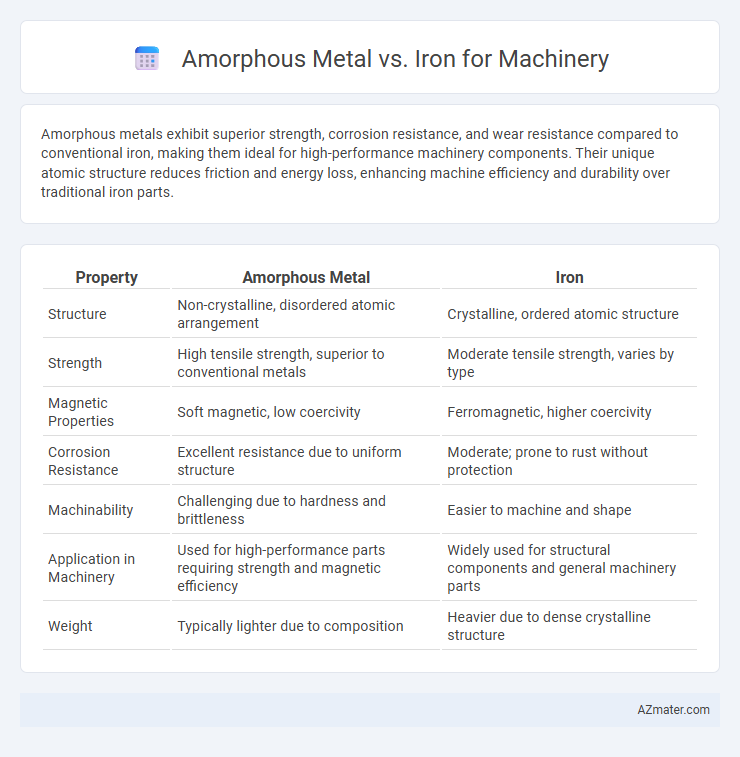Amorphous metals exhibit superior strength, corrosion resistance, and wear resistance compared to conventional iron, making them ideal for high-performance machinery components. Their unique atomic structure reduces friction and energy loss, enhancing machine efficiency and durability over traditional iron parts.
Table of Comparison
| Property | Amorphous Metal | Iron |
|---|---|---|
| Structure | Non-crystalline, disordered atomic arrangement | Crystalline, ordered atomic structure |
| Strength | High tensile strength, superior to conventional metals | Moderate tensile strength, varies by type |
| Magnetic Properties | Soft magnetic, low coercivity | Ferromagnetic, higher coercivity |
| Corrosion Resistance | Excellent resistance due to uniform structure | Moderate; prone to rust without protection |
| Machinability | Challenging due to hardness and brittleness | Easier to machine and shape |
| Application in Machinery | Used for high-performance parts requiring strength and magnetic efficiency | Widely used for structural components and general machinery parts |
| Weight | Typically lighter due to composition | Heavier due to dense crystalline structure |
Introduction to Amorphous Metals and Iron
Amorphous metals, also known as metallic glasses, possess a disordered atomic structure unlike the crystalline arrangement found in traditional iron, which results in superior strength, corrosion resistance, and elasticity. Iron, a widely used ferrous metal in machinery, offers high tensile strength and durability but is prone to corrosion and wear under harsh conditions. The unique properties of amorphous metals make them ideal for specialized machinery applications where enhanced performance and longevity are critical.
Structural Differences: Amorphous vs. Crystalline Iron
Amorphous metals feature a non-crystalline atomic structure characterized by a random, disordered arrangement of atoms, contrasting sharply with the well-ordered, lattice-based crystalline structure of iron. This structural difference imparts amorphous metals with superior strength, improved corrosion resistance, and reduced magnetic losses compared to traditional iron, which often suffer from grain boundary weaknesses and susceptibility to rust. Machinery components made from amorphous metals benefit from higher wear resistance and fatigue life, making them ideal for demanding mechanical applications where iron's crystalline structure may lead to structural failure.
Mechanical Properties Comparison
Amorphous metals exhibit significantly higher strength and hardness compared to conventional iron, thanks to their non-crystalline atomic structure that eliminates dislocation movements. Iron, while ductile and relatively easy to machine, typically shows lower tensile strength and a higher tendency to deform under stress than amorphous metals. The elastic limit and wear resistance of amorphous metals outperform iron, making them ideal for high-performance machinery components requiring superior durability and reduced maintenance.
Wear Resistance and Durability
Amorphous metals exhibit superior wear resistance and durability compared to conventional iron, due to their non-crystalline atomic structure that minimizes dislocation movement and surface degradation under mechanical stress. This structure imparts higher hardness and improved resistance to abrasion, making amorphous metals ideal for machinery components exposed to harsh operating conditions. In contrast, iron's crystalline structure is more prone to fatigue and wear, resulting in shorter service life and increased maintenance requirements.
Magnetic Properties in Machinery Applications
Amorphous metals exhibit superior magnetic properties compared to traditional iron, characterized by lower coercivity and higher magnetic permeability, which reduces energy losses in machinery such as transformers and motors. Their non-crystalline structure minimizes eddy current and hysteresis losses, enhancing efficiency and performance in high-frequency applications. Iron, while cost-effective and widely used, suffers from higher core losses due to its crystalline grain boundaries, making amorphous metals a preferred choice for advanced magnetic components in precision machinery.
Corrosion Resistance: Amorphous Metal vs. Iron
Amorphous metals exhibit significantly higher corrosion resistance compared to traditional iron due to their non-crystalline atomic structure, which eliminates grain boundaries that typically serve as corrosion initiation sites. This structural advantage results in superior resistance to oxidative and chemical degradation, making amorphous metals ideal for machinery exposed to harsh environments. Iron, with its crystalline structure, is more susceptible to rust and corrosion, often requiring protective coatings or treatments to enhance durability.
Manufacturing and Processing Techniques
Amorphous metals, made through rapid solidification techniques such as melt spinning, exhibit non-crystalline structures that provide superior wear resistance and strength compared to conventional iron used in machinery components. Iron manufacturing typically involves casting, forging, and heat treatment processes that promote crystalline grain formation, resulting in predictable mechanical properties but lower hardness and fatigue resistance than amorphous metals. Advances in additive manufacturing and precise cooling control enable amorphous metals to achieve optimized mechanical performance, reducing the need for further machining compared to traditional iron parts.
Cost Analysis and Material Availability
Amorphous metals exhibit higher production costs compared to traditional iron due to complex manufacturing processes like rapid solidification and limited large-scale suppliers. Iron, widely available and abundant globally, benefits from established supply chains and lower raw material expenses, making it more cost-effective for large-scale machinery applications. However, the long-term operational savings of amorphous metals through enhanced durability and reduced maintenance can offset initial cost disadvantages in specialized machinery components.
Energy Efficiency in Machinery Performance
Amorphous metal exhibits significantly higher energy efficiency in machinery performance compared to traditional iron due to its unique disordered atomic structure, which minimizes magnetic losses and reduces hysteresis. This intrinsic property leads to lower heat generation and energy consumption during operation, enhancing overall machine reliability and lifespan. In contrast, iron-based materials suffer from greater energy dissipation, making amorphous metals more suitable for high-efficiency industrial applications.
Future Prospects and Industry Adoption
Amorphous metals, with their superior strength-to-weight ratio and corrosion resistance compared to traditional iron, offer promising advancements for future machinery applications. Industry adoption is accelerating as manufacturers seek materials that enhance energy efficiency and durability in sectors like automotive and aerospace. Continued research into cost-effective production methods is expected to drive wider integration of amorphous metals, potentially surpassing iron in critical industrial uses.

Infographic: Amorphous metal vs Iron for Machinery
 azmater.com
azmater.com